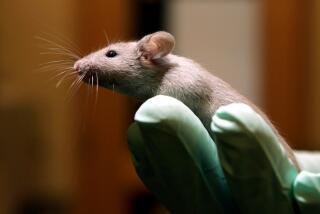Minnies Didn’t Need Mickey to Be Moms
- Share via
Scientists in Tokyo have produced mice with two genetic mothers and no father, the first time the feat has been accomplished in mammals.
They said the technique cannot be used on people, for reasons both technical and ethical. In fact, one of the mouse mothers was a mutant whose DNA had been altered to make it act like a male’s contribution to an embryo.
The feat is reported in today’s issue of the journal Nature by Tomohiro Kono of the Tokyo University of Agriculture in Japan.
He and colleagues say they produced two mice, one of which grew to maturity and gave birth. Kono said this mouse appears to be healthy.
Experts said ethical concerns and current technology would pose barriers to duplicating the technique in people. For one thing, scientists do not know how to create the precise DNA mutation in humans.
However, the study provides new evidence for the standard explanation of why mammals normally need a male’s DNA. Scientists say that in an embryo, some mammal genes behave differently if inherited from the father, and that this paternal activity pattern is needed for normal development.
Researcher Kent Vrana said the Nature study is encouraging for another reason. If a healthy, fertile mouse can be produced without a father’s DNA, he said, that gives hope that stem cells from a similar process would behave normally.






